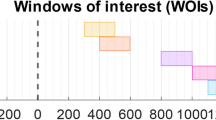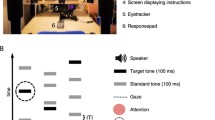Abstract
There is increasing evidence that spontaneous eye blinks are related to mental states and can predict performance in certain tasks because of their relation to dopaminergic activity. Moreover, it has been shown that eye blinks while performing visual tasks are preferably executed not before all available information and even the manual response has been processed and given. Thus, blinks provide a natural endpoint of visual information processing. In the present study, we investigate to what degree such functional assignment of eye blinks also applies when only auditory stimuli are processed. For that, we present blink analyses on data of an auditory stock price monitoring task to examine the timing and frequency of blinks relative to the temporal dynamics of the task and different kinds of available cues. Our results show that blinks are meaningfully rather than randomly paced, although no visual information has to be processed. Blinks are significantly accelerated if a no-go trial is indicated which made all the subsequent information irrelevant. Although the stimuli were exclusively auditory, blinks were mostly inhibited during stimulus presentation. Taken together, blinks depend on the information being presented and mark a distinct point in time at which this information is conclusively processed. These findings deliver further support for the usefulness of eyeblink analyses, independently of the modality of the information being processed.





Similar content being viewed by others
References
Adam, A. R., Mallan, K. M., & Lipp, O. V. (2009). The effect of emotional and attentional load on attentional startle modulation. International Journal of Psychophysiology, 74(3), 266–273.
Boksem, M. A. S., & Tops, M. (2008). Mental fatigue: Costs and benefits. Brain Research Reviews, 59(1), 125–139.
Bonneh, Y. S., Adini, Y., & Polat, U. (2016). Contrast sensitivity revealed by spontaneous eyeblinks: Evidence for a common mechanism of oculomotor inhibition. Journal of Vision, 16(7), 1.
Bradley, M. M., Cuthbert, B. N., & Lang, P. J. (1991). Startle and emotion: Lateral acoustic probes and the bilateral blink. Psychophysiology, 28(3), 285–295.
Bregman, A. (1990). Auditory scene analysis: The perceptual organization of sound. Cambridge: MIT Press.
Cherry, E. C. (1953). Some experiments on the recognition of speech, with one and with two ears. The Journal of the Acoustical Society of America, 25(5), 975–979.
Colzato, L. S., van den Wildenberg, W. P. M., van Wouwe, N. C., Pannebakker, M. M., & Hommel, B. (2009). Dopamine and inhibitory action control: Evidence from spontaneous eye blink rates. Experimental Brain Research, 196(3), 467–474.
Darwin, C. J. (2008). Listening to speech in the presence of other sounds. Philosophical Transactions of the Royal Society of London Series B Biological Sciences, 363(1493), 1011–1021.
Delorme, A., & Makeig, S. (2004). EEGLAB: An open source toolbox for analysis of single-trial EEG dynamics including independent component analysis. Journal of Neuroscience Methods, 134(1), 9–21.
Doughty, M. J., & Naase, T. (2006). Further analysis of the human spontaneous eye blink rate by a cluster analysis-based approach to categorize individuals with “normal” versus “frequent” eye blink activity. Eye and Contact Lens, 32(6), 294–299.
Fitzpatrick, E., Hohl, N., Silburn, P., O’Gorman, C., & Broadley, S. A. (2012). Case–control study of blink rate in Parkinson’s disease under different conditions. Journal of Neurology, 259(4), 739–744.
Fukuda, K. (2001). Eye blinks: New indices for the detection of deception. International Journal of Psychophysiology, 40(3), 239–245.
Getzmann, S., & Falkenstein, M. (2011). Understanding of spoken language under challenging listening conditions in younger and older listeners: A combined behavioral and electrophysiological study. Brain Research, 1415, 8–22.
Getzmann, S., Lewald, J., & Falkenstein, M. (2014). Using auditory pre-information to solve the cocktail-party problem: Electrophysiological evidence for age-specific differences. Frontiers in Neuroscience, 8(DEC), 1–13.
Groman, S. M., James, A. S., Seu, E., Tran, S., Clark, T. A., Harpster, S. N., Jentsch, J. D. (2014). In the blink of an eye: Relating positive-feedback sensitivity to striatal dopamine D2-like receptors through blink rate. The Journal of Neuroscience, 34(43), 14443–14454.
Karson, C. N. (1983). Spontaneous eye-blink rates and dopaminergic systems. Brain, 106(3), 643–653.
Lipp, O. V., Blumenthal, T. D., & Adam, A. R. (2001). Attentional modulation of blink startle at long, short, and very short lead intervals. Biological Psychology, 58(2), 89–103.
Lipp, O. V., Siddle, D. A. T., & Dall, P. J. (1997). The effect of emotional and attentional processes on blink startle modulation and on electrodermal responses. Psychophysiology, 34(3), 340–347.
Mackert, A., Flechtner, K. M., Woyth, C., & Frick, K. (1991). Increased blink rates in schizophrenics. Influences of neuroleptics and psychopathology. Schizophrenia Research, 4(1), 41–47.
Meyberg, S., Werkle-Bergner, M., Sommer, W., & Dimigen, O. (2015). Microsaccade-related brain potentials signal the focus of visuospatial attention. Neuroimage, 104, 79–88.
Nakano, T. (2015). Blink-related dynamic switching between internal and external orienting networks while viewing videos. Neuroscience Research, 96, 54–58.
Nakano, T., Kato, M., Morito, Y., Itoi, S., & Kitazawa, S. (2013). Blink-related momentary activation of the default mode network while viewing videos. Proceedings of the National Academy of Sciences of the United States of America, 110(2), 702–706.
Nakano, T., Yamamoto, Y., Kitajo, K., Takahashi, T., & Kitazawa, S. (2009). Synchronization of spontaneous eyeblinks while viewing video stories. Proceedings of Biological Sciences The Royal Society, 276(1673), 3635–3644.
Oh, J., Jeong, S.-Y., & Jeong, J. (2012). The timing and temporal patterns of eye blinking are dynamically modulated by attention. Human Movement Science, 31(6), 1353–1365.
Orchard, L. N., & Stern, J. A. (1991). Blinks as an index of cognitive activity during reading. Integrative Physiological and Behavioral Science, 26(2), 108–116.
Pannasch, S., Dornhoefer, S. M., Unema, P. J., & Velichkovsky, B. M. (2001). The omnipresent prolongation of visual fixations: Saccades are inhibited by changes in situation and in subject’s activity. Vision Research, 41(25–26), 3345–3351.
Rolfs, M., Kliegl, R., & Engbert, R. (2008). Toward a model of microsaccade generation: The case of microsaccadic inhibition. Journal of Vision, 8(11), 5.1–23.
Sarter, M., Gehring, W. J., & Kozak, R. (2006). More attention must be paid: The neurobiology of attentional effort. Brain Research Reviews, 51, 145–160.
Shin, Y. S., Chang, W., Park, J., Im, C.-H., Lee, S. I., Kim, I. Y., & Jang, D. P. (2015). Correlation between inter-blink interval and episodic encoding during movie watching. PLoS One, 10(11), e0141242.
Slagter, H. A., Georgopoulou, K., & Frank, M. J. (2015). Spontaneous eye blink rate predicts learning from negative, but not positive, outcomes. Neuropsychologia, 71(March 2016), 126–132.
Sweeney, D. F., Millar, T. J., & Raju, S. R. (2013). Tear film stability: A review. Experimental Eye Research, 117, 28–38.
Taylor, J. R., Elsworth, J. D., Lawrence, M. S., Sladek, J. R., Roth, R. H., & Redmond, D. E. (1999). Spontaneous blink rates correlate with dopamine levels in the caudate nucleus of MPTP-treated monkeys. Experimental Neurology, 158(1), 214–220.
Valsecchi, M., & Turatto, M. (2009). Microsaccadic responses in a bimodal oddball task. Psychological Research Psychologische Forschung, 73(1), 23–33.
van Bochove, M. E., Van der Haegen, L., Notebaert, W., & Verguts, T. (2013). Blinking predicts enhanced cognitive control. Cognitive Affective and Behavioral Neuroscience, 13(2), 346–354.
van der Post, J., de Waal, P. P., de Kam, M. L., Cohen, A. F., & van Gerven, J. M. A. (2004). No evidence of the usefulness of eye blinking as a marker for central dopaminergic activity. Journal of Psychopharmacology (Oxford, England), 18(1), 109–114.
Verleger, R. (1991). The instruction to refrain from blinking affects auditory P3 and N1 amplitudes. Electroencephalography and Clinical Neurophysiology, 78(3), 240–251.
Wascher, E., Heppner, H., & Hoffmann, S. (2014). Towards the measurement of event-related EEG activity in real-life working environments. International Journal of Psychophysiology, 91(1), 3–9.
Wascher, E., Heppner, H., Kobald, S. O., Arnau, S., Getzmann, S., & Möckel, T. (2016). Age-sensitive effects of enduring work with alternating cognitive and physical load. A study applying mobile EEG in a real life working scenario. Frontiers in Human Neuroscience, 9(January), 711.
Wascher, E., Heppner, H., Möckel, T., Kobald, S. O., & Getzmann, S. (2015). Eye-blinks in choice response tasks uncover hidden aspects of information processing. EXCLI Journal, 14, 1207–1218.
Widmann, A., Engbert, R., & Schröger, E. (2014). Microsaccadic responses indicate fast categorization of sounds: A novel approach to study auditory cognition. The Journal of Neuroscience, 34(33), 11152–11158.
Zhang, T., Mou, D., Wang, C., Tan, F., Jiang, Y., Lijun, Z., & Li, H. (2015). Dopamine and executive function: Increased spontaneous eye blink rates correlate with better set-shifting and inhibition, but poorer updating. International Journal of Psychophysiology, 96(3), 155–161.
Zhang, T., Wang, C., Tan, F., Mou, D., Zheng, L., & Chen, A. (2016). Different relationships between central dopamine system and sub-processes of inhibition: Spontaneous eye blink rate relates with N2 but not P3 in a Go/Nogo task. Brain and Cognition, 105(6), 95–103.
Acknowledgements
We would like to thank two anonymous reviewers for their helpful comments on a previous version of this manuscript.
Funding
The original study was funded by the Deutsche Forschungsgemeinschaft (DFG GE 1920/3-1).
Author information
Authors and Affiliations
Corresponding author
Ethics declarations
Conflict of interest
All authors declare no conflict of interest.
Ethical approval
This study was in compliance with the Declaration of Helsinki and was approved by the local ethics committee of the Leibniz Research Centre for Working Environment and Human Factors. All participants gave their informed written consent prior to the experimental procedures.
Electronic supplementary material
Below is the link to the electronic supplementary material.
Rights and permissions
About this article
Cite this article
Kobald, S.O., Wascher, E., Heppner, H. et al. Eye blinks are related to auditory information processing: evidence from a complex speech perception task. Psychological Research 83, 1281–1291 (2019). https://doi.org/10.1007/s00426-017-0952-9
Received:
Accepted:
Published:
Issue Date:
DOI: https://doi.org/10.1007/s00426-017-0952-9




